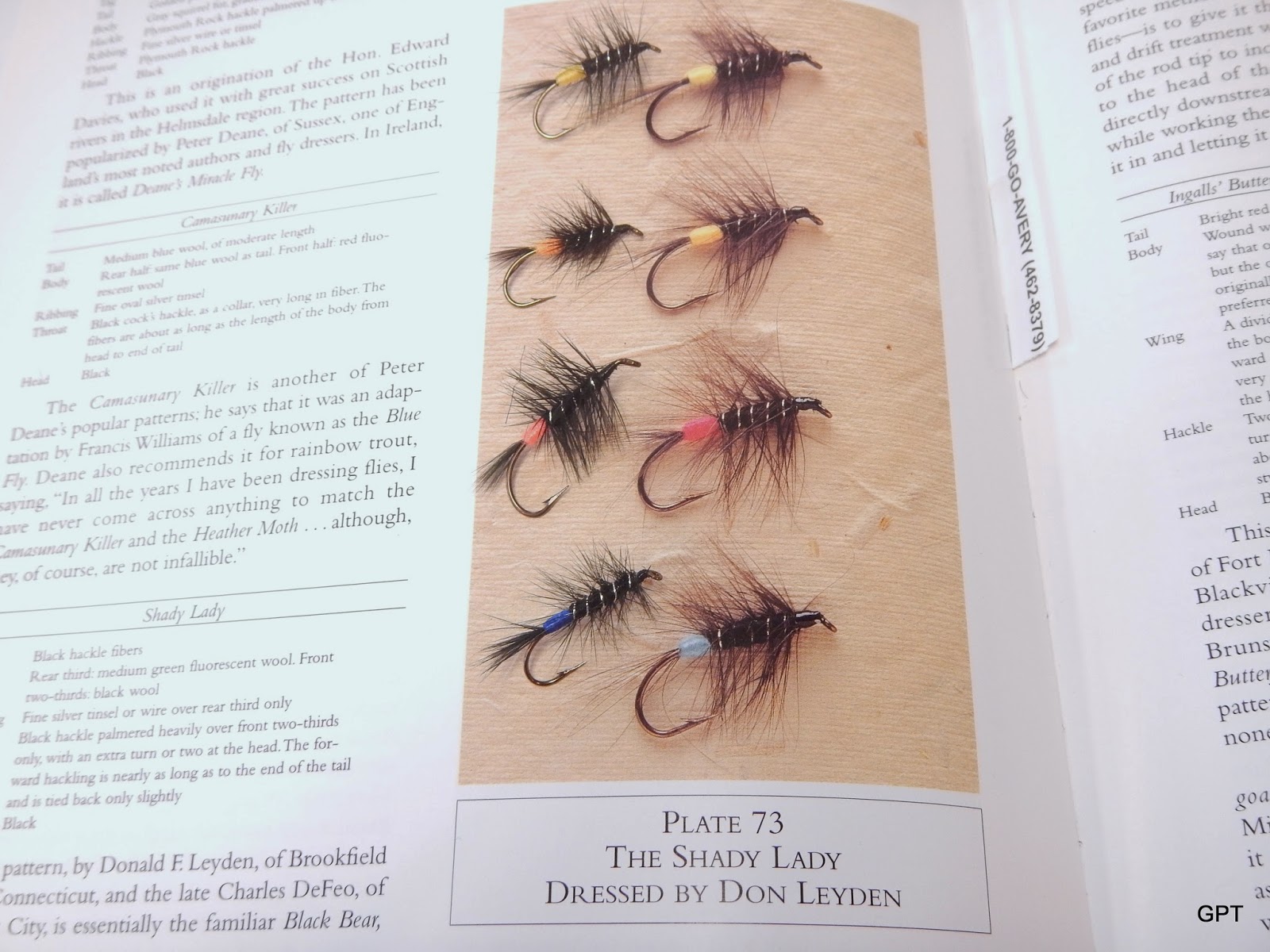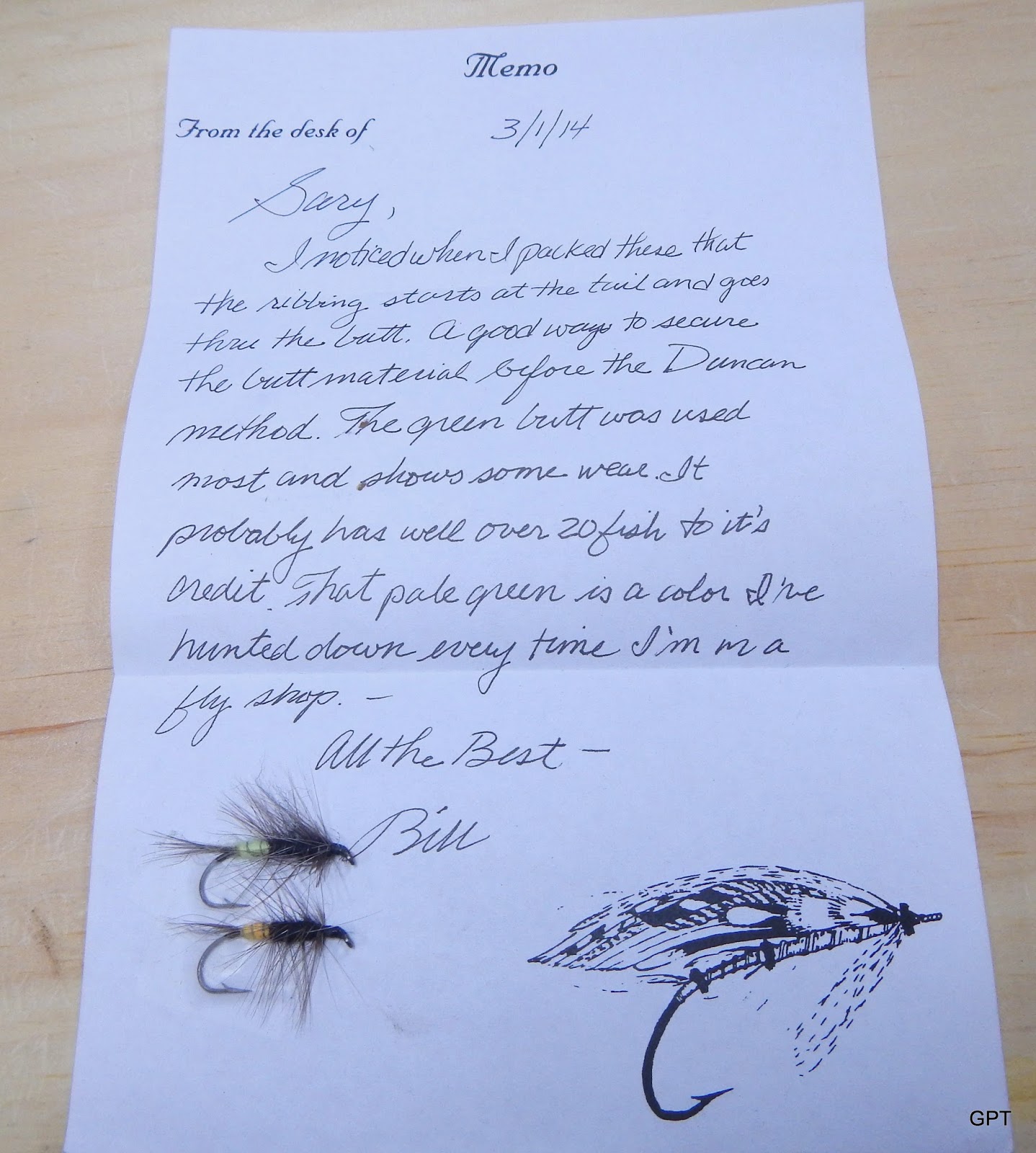Back in the early 1950's, the late Don Leyden of Connecticut and the late Charles DeFeo of New York City, both avid salmon fisherman, developed the Shady Lady (Bates & Bates, Fishing Atlantic Salmon; the Flies and the Patterns, Stackpole, 1996). As those authors note, the fly "...is essentially the familiar Black Bear Green Butt, with hackling substituted for the wing."
The pattern: Tail: Black hackle fibers
Body: Rear third: medium green flourescent wool (or other flourescent wool colors)
Front two thirds: black wool
Ribbing: Fine silver tinsel (more about this in a bit)
Hackle: Black hackle palmered heavily over the front two thirds of the body
Head: Black
Photo from page 194 of Bates and Bates; my ties of the fly on the left, Leyden's ties on right:
CLICK ON THE PICS FOR THE BIG PICTURE
Interestingly, the ribbing, as described in Bates and Bates, is only applied to the black wool (forward two thirds) of the body. However, my salmon camp pal Bill Tomiello knew Leyden well, and sent me a couple Shady Ladies Don tied and gave to him. On these Ladies, Don started the ribbing all the way at the back of the fly, going over the flourescent wool as well as the black. Probably a good way to keep the butt tied down (an interesting - well, to me, anyway - side note: the method of locking in the butt, be it wool, floss or whatever, by bringing a piece of the material back over itself is commonly referred to as "Dunc's (Warren Duncan's) method. My friend Brian Cuming of Fredricton, NB actually showed the method to Dunc at a fly tying gathering years ago in Fredricton; Dunc just popularized it.)
Bill's note to me and the flies Leyden tied for him:
The traditional Shady Lady remains a very effective atlantic salmon fly. But what's up with having to describe it as traditional ? Well, I bet if you ask most salmon fly anglers today if they have a Shady Lady in their fly box, they're going to dig around and hand you one of these - AKA a buck bug:
Lots of similarities of course, to Leyden's creation...the main difference is the spun deer hair body (hence, buck bug). Often, as in the case of this fly, the tail has gone from being a bit of chicken feather to the tyer's flash du jour; krystal flash in this instance.
Where did bugs come from? As with many things fly fishing, depends on who ya ask. If you want to have some fun, get a bunch of old fly anglers together and ask questions like, "Who gets paternity for the dry fly in America ?" or "Who invented the streamer ?" The discussion can get ugly quickly, trust me. But I digress.
The good Reverend Elmer Smith (he of Bomber fame) is given credit in several sources for the development of the buck bug. Dick Stewart and Farrow Allen, in their Flies for Atlantic Salmon (Northland Press, 1991) reported that "It is generally believed that the idea for the buck bug came from Father Elmer Smith...and is essentially a direct descendant of the highly successful Bomber that was introduced on the Miramichi during the early '60's."
Michael Brislain, in his Bugging the Atlantic Salmon (Goose Lane Editions, 1995) comes right out and says it: "...in 1970, Father Smith developed and used the first bug patterns, supposedly on New Brunswick's Nashwaak River."
But...but...but what about Bill Carter and his Carter's Bug??? It's 1961, and Bill (long story short) is watching salmon in a pool, tosses a little piece of moss into the pool from his rock ledge vantage point, and watches big salmon attack it. Goes home and ties what becomes Carter's Bug with loosely packed deer hair to imitate that piece of moss (paraphrased from Dewey Gillespie and Walter Kitchen's Where the Rivers Meet; The Fly Tyers of New Brunswick the 2nd Time Around. Their great bio's of New Brunswick tyers can be found at www.flyfishingnb.com .
Here's a Carter's Bug, tied by none other than Bryant Freeman, the man to see for a Carter's Bug since Bill stopped tying. Bryant has a great fly shop, Eskape Angler in Riverview, New Brunswick, and lots of history and beautiful flies on his site: www.eskapeanglers.com . You can learn the correct way to tie and fish the Carter's Bug there - if you don't have some in your fly box, you should. It has always been a very effective fly.
So here we have two "sets", if you will, of essentially brown bugs being developed at approximately the same time in New Brunswick. That happens. I bet Aelian wasn't the only guy on the planet dapping some kind of fly into his home stream/river/lake/pond/whatever back around 200 A.D. Oh, wait, that's right, Dame Julianna invented fly fishing....ok, I won't go there (lol, see above, dry fly paternity. gets ugly fast).
But we're still not up to the buck bug Shady Lady, are we? We need to explore some more, shall we say, divergent opinions first. To get to the Shady Lady, somebody had to start using dyed deer hair for the body.
Enter THE GREEN MACHINE, the fly, to use my buddy and ridiculously good New Brunswick fly tyer Rob Feeney's description of it, the fly I love to hate.
On Gillespie and Kitchen's site (wwww.flyfishingnb.com), there's a biography of Emerson Underhill, wherein Emerson tells the story of how he was experimenting with deer hair, to tie, of all things, the Shady Lady. He dyed a lot of different colors, epecially green, and was spinning a hook with it when a young fella, who had been watching (this was at the farmer's market in Doaktown, NB in the early 1980's) named it the Green Machine for Emerson.
At the same time - and this is related in an article that Jerry Doak, proprietor of the famous W.W. Doak Fly Shop in Doaktown, NB (www.doak.com) wrote for American Fly Tyer magazine in 1987 as well as in Steve Raymond's Blue Upright; The Flies of a Lifetime (The Lyons Press, 2004) - an uncle of Miramichi guide, name of Evelock Gilks, was with a sport in Labrador where they saw an "unidentified, green clipped deer hair flies" in use. He relayed the intel to Evelock, and he and some others played around with colors. They didn't have a lot of white deer hair to dye, so the brown they dyed green came out kind of olive. Eventually the fly got greener, and was known locally as the Green Gobbler. I'm pretty sure it was Bryant Freeman who, after a great day with the bug, named it the Green Machine. Jerry Doak did a heck of a job promoting the fly, and it's likely the most used fly on the Miramichi these days (he said with a sigh.)
So once again a fly may have evolved in two locations (albeit very close locations at the same time. It happens.
The only Green Machine I'll ever tie (unless of course, someone orders them from me, then I'll be more than happy to tie 'em):
If you want to learn to tie one, my bud Howie Gould is the best there is at buck bugs, and you can watch his step by step video on tying one at his blog: http://thewulffden.blogspot.com/2014/01/a-wulff-den-style-buck-bug.html
Ugh, sidetracked by the Green Machine. Where were we? Ah, yes, the Shady Lady. This one appears to only have one possible answer: the Shady Lady became a buck bug the day, back in the early '80's, that Emerson Underhill was having trouble making the hackle behave on some chenille-bodied Ladies he was tying. He reasoned he'd have less trouble with a spun deer hair body, and he did. The bug buck Shady Lady was born (read more on nbflyfishing.com). It was about 1980.
I've fished a buck bug Shady Lady once...and hooked and landed a grilse on the first cast with it. So I of course promptly switched back to a hairwing.
Well, yes, I know the bug version works, but I still like the original flavor better:








Love the Blog as always keep up the Great work Gary!! Julian and Karl.
ReplyDeleteThanks, guys! Hope to see you this summer or fall!
DeleteGary,
ReplyDeleteYou have a knack for weaving historical flies and traditions with modern applications. Thanks for taking the time to share your research and stories with all of us.
Doug
It's a lot of fun for me to do the research, read the books, talk to folks, Doug...very glad you enjoy the results!
DeleteOne of my favorite flies,Gary, in the original version, although I've used both. Yes, it was Dunc who showed me how to keep the butts from running down the bend of the hook although not the originator as you pointed out.
ReplyDeleteI'm with you on the bugs. Anyone can catch a fish on a Green Machine. LOL
Interesting post as usual. Thanks.
Richard, I'm with you on the Green Machine! LOL! Hope to meet you this summer!
DeleteInteresting patterns.
ReplyDeleteThe first two would work well on some of the small trout streams I fish. Tied smaller of course.
Thanks.
Alan, I've swung smaller versions, as you suggest, for trout, and they like them! I was using size 10's.
DeleteI'd bring cigars to your campfire anytime!
ReplyDeleteGreat writing!
Thank you! Bring 'em on!
DeleteGreat blog entry, Gary! Thanks for sharing that bit of fly tying history :)
ReplyDeleteHope lots of folks watch your bug tying video, Howie, its the best!
DeleteGreat entry Gary, but don't you feel a bit compromised? :)
ReplyDeleteLOL, Mark, you know how I feel about bugs, but I always like to tell both sides of the story....even if one side is just wrong (heh heh!)
DeleteSeriously, very happy you enjoyed it!
Gary I enjoyed your writing as usual. A funny occurrence for me last summer was a request for me to tye some of the old style Shady Lady's not that "damn bug" version. Like you , both this fellow and I are anti-bug fishermen.
ReplyDeleteLove that you are keeping the history alive! --can't wait for your next installment--
Brian C
Glad you enjoyed the post, Brian. One thing's for sure, a wool-bodied SL is a heck of a lot easier/faster to tie than the spun deer hair version (and don't tell anyone I said this, but probably at least as effective!)
ReplyDelete